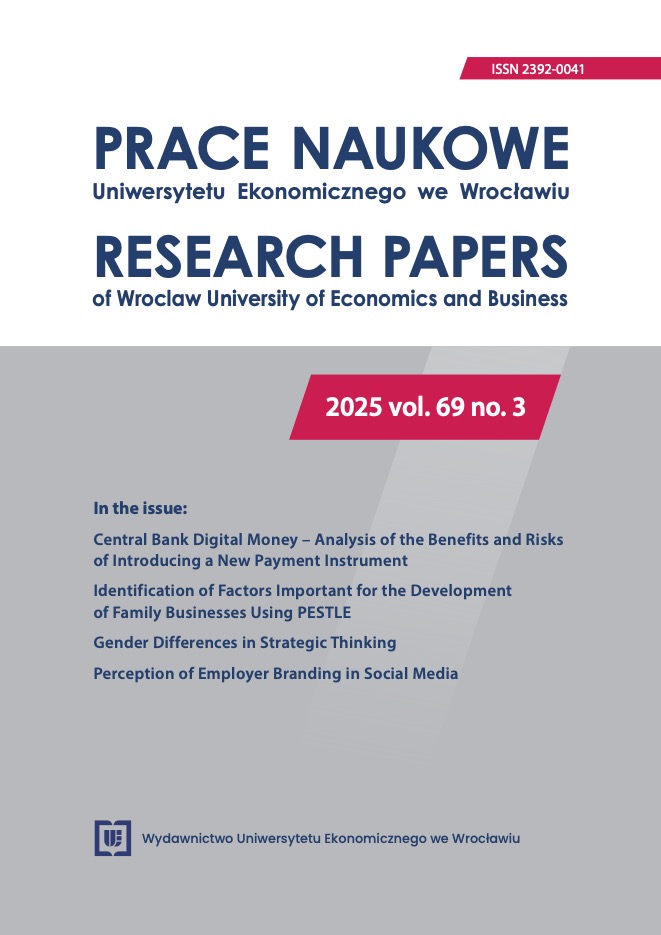Central Bank Digital Money – Analysis of the Benefits and Risks of Introducinga New Payment Instrument
DOI:
https://doi.org/10.15611/pn.2025.3.02Keywords:
central bank digital money, financial system, central bankAbstract
Objective: The aim of this work is to characterize central bank digital money as a new payment instrument in the context of an analysis of the potential benefits and risks associated with it. This article presents models of CBDC operation, indicating their characteristics, and the current state of work in the process of implementing this instrument in selected countries.
Methodology: This work utilizes methods of literature analysis, descriptive and comparative analysis. This article presents models of CBDC operation, indicating their characteristics, and the current state of work in the process of implementing this instrument in selected countries. The authors of the study pay particular attention to the benefits of implementing CBDC, as well as the risks associated with its introduction into circulation.
Results: Central bank digital money (CBDC) is a new type of payment instrument associated with the development of new technologies in the financial market. Faced with the dynamic development of financial technologies and the growing interest in digital currencies in the private sector, central banks around the world are intensifying research into the potential of their own digital forms of money. The conceptual and analytical work conducted to date, as well as experiments and initial implementations, do not allow for a clear assessment of the benefits associated with using this instrument.
Implications and Recommendations: Conceptual work on CBDC has begun in many countries around the world. For economies with relatively low levels of financial market development, central bank digital money could become an innovative solution that positively impacts the efficiency of payment systems. However, for most countries, it will only complement existing payment instruments. Currently, the most advanced work on digital money issuance is in countries with inefficient payment systems, disruptions in the payment services market, or a decline in the use of cash in retail transactions. The hypothetical benefits supporting the initiation of more advanced work on digital currency issuance refer to the experiences of countries where pilot programs are being conducted or the implementation of this instrument has been subjected to in-depth analysis. The varying conditions surrounding the introduction of CBDC and the multitude of variants across countries mean that CBDC is not a universal instrument.
Originality/Value: The introduction of CBDC into circulation creates a number of new opportunities that could significantly modify the functioning of global financial systems. Taking into account the fact that the introduction of CBDC means a change in the current architecture of national monetary systems, this process requires the development of new, effective and secure organizational, technical and operational solutions as well as a significant degree of credibility in relation to state institutions and an adequate information policy.
Downloads
References
Antony, N. i Mitchell, N. (2023). Central Bank Digital Currency. Assessing the Risks and Dispelling the Myths. https://www.cato.org/policy-analysis/central-bank-digital-currency
Asian Development Bank. (2023). The Role of Central Bank Digital Currencies in Financial Inclusion. https://www.adb.org/sites/default/files/publication/871281/asia-pacific-financial-inclusion-forum-2022.pdf
Atlantic Council. (2022). Jamaica Launches its CBDC Pilot Project: The First Digital Currency in the Caribbean. https://www.atlanticcouncil.org
Bank for International Settlements (BIS). (2021). CBDCs: An Opportunity for Financial Stability? https://www.bis.org
Bank of England. (2020). Central Bank Digital Currency. Opportunities, Challenges and Design. https://www.bankofengland.co.uk/-/media/boe/files/paper/2020/central-bank-digital-currency-opportunities-challenges-and-design.pdf
Bank of Japan. (2021). The Bank of Japan's Approach to Central Bank Digital Currency. https://www.boj.or.jp/en/about/release_2020/rel201009e.htm
Boar, C. i Wehrli, A. (2021). Ready, Steady, Go? – Results of the Third BIS Survey on Central Bank Digital Currency. BIS Paper, (114). https://www.bis.org/publ/bppdf/bispap114.htm
Burton, D. (2022). Jamaica Becomes the First Caribbean Country to Launch a Digital Currency. Caribbean Business. https://caribbeanbusiness.com/jamaica-digital-currency-launch/
Carstens, A. (2021). Central Bank Digital Currencies: Putting a Big Idea into Practice. Bank for International Settlements. https://www.bis.org/speeches/sp210331.htm
CBDC Tracker. (2023). Today's Central Bank Digital Currencies Status. https://cbdctracker.org
Central Bank of Brazil. (2022). Brazilian Central Bank Digital Currency – Project and Perspectives. https://www.bcb.gov.br/en/financialstability/cbdc
Committee on Payments and Market Infrastructures i Markets Committee. (2018). Central Bank Digital Currencies. https://www.bis.org/cpmi/publ/d174.pdf
European Central Bank. (2020). The Digital Euro: Opportunities and Challenges. https://www.ecb.europa.eu
European Central Bank. (2021). Report on a Digital Euro. https://www.ecb.europa.eu/pub/pdf/other/2101_opinion_digitaleuro.en.pdf
European Central Bank. (2023). Progress on the Investigation Phase of a Digital Euro – Fourth Report. https://www.ecb.europa.eu/paym/digital_euro/investigation/governance/shared/files/ecb.degov230713-f…
Federal Reserve. (2022). Money and Payments: The U.S. Dollar in the Age of Digital Transformation. https://www.federalreserve.gov/publications/files/money-and-payments-20220120.pdf
Gorton, G. (2021). The End of the Traditional Banking System? Central Bank Digital Currencies and the Future of Financial Systems. Yale School of Management.
Harasim, J. (2021). FinTechs, BigTechs and Banks – When Cooperation and When Competition? Journal of Risk and Financial Management, 14(12), 614. https://doi.org/10.3390/jrfm14120614
Infante, S., Kim, K., Silva, A. i Tetlow, R. (2022). The Macroeconomic Implications of CBDC: A Review of the Literature. FEDS Working Paper, 2022-76. https://www.federalreserve.gov/econres/feds/files/2022076pap.pdf
Iwańczuk-Kaliska, A. (2018). Pieniądz cyfrowy banków centralnych − wnioski z analizy wybranych koncepcji. Prace Naukowe Uniwersytetu Ekonomicznego we Wrocławiu, (531), 180-189. http://cejsh.icm.edu.pl/cejsh/element/bwmeta1.element.desklight-b2bff12a-2275-46ac-a0c1-757d1cb598cd
Iwańczuk-Kaliska, A. (2021). The Swedish E-krona and the Future of Cash in Sweden. Financial Policy Institute.
Kightley, M., Żak, R. i Dulinicz, M. (2022). Evaluation of the Rationale for the Potential Introduction of Central Bank Digital Currency in Poland. BIS Papers, (123), 161-165.
Kuroda, H. (2020). Bank of Japan's Digital Yen Initiative. Bank of Japan Annual Report.
Ledger Insights. (2023). China’s Digital Yuan (e-CNY): A Guide to the World’s Most Advanced CBDC Project. https://www.ledgerinsights.com/china-digital-yuan
Mancini-Griffoli, T., Soledad, M., Peria, M., Agur, I., Ari, A., Kiff, J., Popescu, A. i Rochon, C. (2018). Casting Light on Central Bank Digital Currencies. Discussion Note (SDN/18/08). https://www.imf.org/en/Publications/Staff-Discussion-Notes/Issues/2018/11/13/Casting-Light-on-Central-Bank-Digital-Currencies-46233
McKinsey. (2022). Central Bank Digital Currencies: An Active Role for Commercial Banks. https://www.mckinsey.com/industries/financial-services/our-insights/central-bank-digital-currencies-an-active-role-for-commercial-banks#/
Narodowy Bank Polski. (2021). Pieniądz cyfrowy banku centralnego. https://nbp.pl/wp-content/uploads/2022/09/raport-cbdc.pdf
Narodowy Bank Polski. (2022). Porównanie wybranych elementów polskiego systemu płatniczego z systemami innych krajów Unii Europejskiej za 2021 r. https://nbp.pl/wp-content/uploads/2023/01/porownanie_UE_2021.pdf
Narodowy Bank Polski. (2023). Informacja o kartach płatniczych IV kwartał 2022 r. https://nbp.pl/wp-content/uploads/2023/05/Informacja-o-kartach-platniczych-Q42022.pdf
Olowole, S. (2021). Nigeria Launches eNaira, Africa’s First Digital Currency. Reuters. https://www.reuters.com/article/us-nigeria-enaira-idUSKBN2A20LS
Peverelli, L. (2023). China’s Digital Yuan: A Growing Presence in the World of CBDCs. World Economic Forum. https://www3.weforum.org/docs/WEF_Central_Bank_Digital_Currency_Global_Interoperability_Principles_2023.pdf
Pfister, C. (2017). Monetary Policy and Digital Currencies: Much Ado about Nothing? Bank of France Working Papers, (642). https://publications.banque-france.fr/sites/default/files/medias/documents/dt-642.pdf
Polski Instytut Ekonomiczny. (2023). Tygodnik Gospodarczy PIE, 23/2023. https://pie.net.pl/wp-content/uploads/2023/06/Tygodnik-PIE_23-2023.pdf
Reuters. (2020). Bahamas Launches the World’s First Fully Operational Central Bank Digital Currency (CBDC). https://www.reuters.com/article/us-bahamas-digital-currency-idUSKBN2A20LS
Schmidt-Jessa, K. (2023). The Impact of COVID-19 on Digital-Only Banks: Are They Winners or Losers? Journal of Banking Regulation, 24, 310-320. https://doi.org/10.1057/s41261-022-00198-0
Schwab, K. (2016). The Fourth Industrial Revolution. Penguin.
Slattery, T. (2014). Taking a Bit out of Crime: Bitcoin and Cross-Border Tax Evasion. Brooklyn Journal of International Law, 39(2), 829-872. https://core.ac.uk/download/pdf/228604591.pdf
Stanley, A. (2022). The Ascent of CBDCs. International Monetary Fund. https://www.imf.org/en/Publications/fandd/issues/2022/09/Picture-this-The-ascent-of-CBDCs
Stevens, A. (2017). Digital Currencies: Threats and Opportunities for Monetary Policy. National Bank of Belgium, Economic Review, 79-92. https://www.nbb.be/doc/ts/publications/economicreview/2017/ecorevi2017_h5.pdf
Sveriges Riksbank. (2021). The E-krona Project: Report 2021. https://www.riksbank.se/globalassets/media/rapporter/e-krona/2021/e-krona-pilot-phase-1.pdf
Swiss National Bank (SNB). (2021). SNB and the Swiss Financial Market Infrastructure: Report on Digital Currencies.
Tolle, M. (2016). Central Bank Digital Currency: The End of Monetary Policy As We Know It? Bank Underground. https://bankunderground.co.uk/2016/07/25/central-bank-digital-currency-the-end-of-monetary-policy-as-we-know-it/
Turrin, R. (2021). Cashless: China's Digital Currency Revolution. Authority Publishing.
Van Wegberg, R., Oerlemans, J. J. i Van Deventer, O. (2018). Bitcoin Money Laundering: Mixed Results? An Explorative Study on Money Laundering of Cybercrime Proceeds Using Bitcoin. Journal of Financial Crime, 25, 419-35. https://www.researchgate.net/publication/323630331_Bitcoin_money_laundering_mixed_results_An_explorative_study_on_money_laundering_of_cybercrime_proceeds_using_bitcoin
Wadsworth, A. (2018). The Pros and Cons of Issuing a Central Bank Digital Currency. Bulletin Reserve Bank of New Zealand, 81(7) https://www.rbnz.govt.nz/-/media/4ee8fb7526804ed2924ad2d4c108fe3a.ashx
Wadsworth, A. (2020). Why Switzerland Is Taking its Time With CBDC. Swiss Financial Market Infrastructure.
Warchlewska, A. (2022). Wykluczenie finansowe. Od finansów tradycyjnych do finansów cyfrowych. Wydawnictwo UEP.
Ward, O. i Rochemont, S. (2019). Understanding Central Bank Digital Currencies (CBDC). Institute and Faculty of Actuaries. https://www.actuaries.org.uk/system/files/field/document/Understanding%20CBDCs%20Final%20-%20disc.pdf
World Bank. (2020). The Role of Digital Currencies in Improving Financial Inclusion. https://www.worldbank.org
Zaleska, M. (2022). Wybrane trendy w bankowości centralnej. Bank i Kredyt, 53(3), 279-294. https://bankikredyt.nbp.pl/content/2022/03/BIK_03_2022_01.pdf
Downloads
Published
License
Copyright (c) 2025 Małgorzata Gasz, Robert Smalara

This work is licensed under a Creative Commons Attribution-ShareAlike 4.0 International License.
Accepted 2025-05-20
Published 2025-10-07









